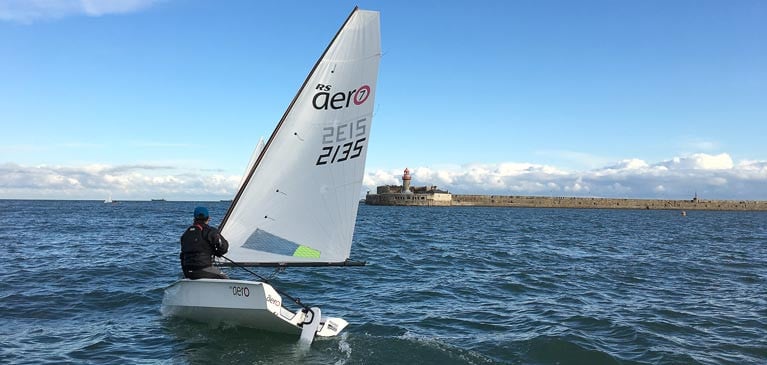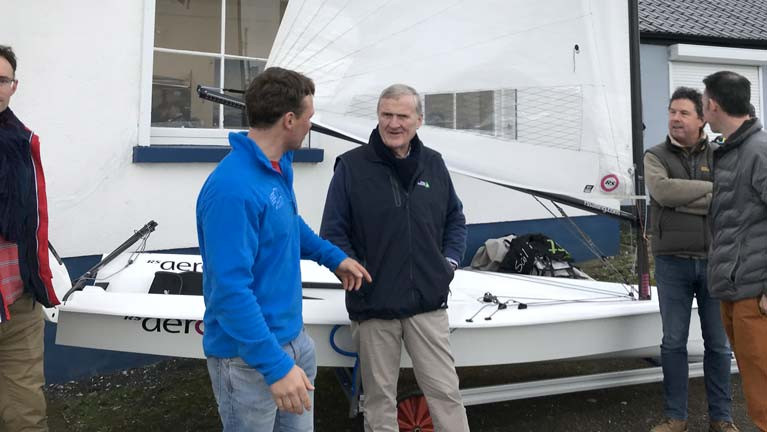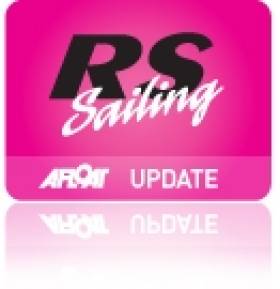Displaying items by tag: Aero
RS Sailing Launch RS Aero 6 Rig
Never one to leave a niche unfilled, RS Sailing have developed the RS Aero 6 rig to fill the gap between the existing 5 and 7 Rigs.
The new development is specifically designed for small adults, removing barriers for women and smaller men who have found themselves in between the previous options of rig sizes.
The new option provides major opportunities particularly for females in the sport.
The new rig system includes a 6.3m² mainsail, which is manufactured by North Sails.
As with all the RS Aero rig systems, a common top-mast and boom has been used, but the new bottom section has a unique stiffness and deck-level bend to ensure the RS Aero 6 rig is incredibly well-balanced.
 The new rig system includes a 6.3m² mainsail, which is manufactured by North Sails
The new rig system includes a 6.3m² mainsail, which is manufactured by North Sails
The radial cut sail is in line with the existing characteristics of the RS Aero 7 mainsail but with a slightly flatter head.
Working closely with an expert carbon fibre tube manufacturer with extensive testing, a new bottom mast section has been designed specific to the Aero 6. This is to ensure that the RS Aero 6 has the amazingly responsive feel that RS Aero owners are known to love.
"The new option provides major opportunities particularly for females in the sport"
With the class continuing to grow in Ireland and the current fleet thriving, it has accomplished 1st-4th top rankings in the DMYC Frostbites PY Class series 1” and with many more participating in the racing series, increasing options will only allow the fleet to grow further both at home and away.
The people buying RS Aeros range from multiple national champions, to people getting back into dinghies, to single-handed sailors looking for something different. While it remains competitive, the class is renowned for its welcoming and friendly approach.
With a busy 2022 Race Calendar, it will be interesting to see what the Aero 6 will do in its debut season.
For more information on anything Aero please don't hesitate to drop an email to [email protected] to organise a demo sail.
Aero 6 rigs will be available from Marine Services, the RS agent in early 2022
“Today we should be reporting on a fantastic first event for the RS Aero in Ireland. The Irish National Sailing & Powerboat School was due to host the inaugural RS Aero Open last Saturday 2nd and Sunday 3rd of May in Dun Laoghaire Harbour, with a strong fleet of over 20 boats from the UK, roughly 20 Irish boats and roughly 10 RS Aeros available for charter between RS Sailing and the Irish Supplier Irish National Marine Services”, laments Glyn Williams of the Irish National Sailing & Powerboat School.
The RS Aero calendar has, like everything, had to adapt to the coronavirus situation. The class has elected for a new date on Saturday 19th and Sunday 20th September, to fit into the currently remaining dates in the RS calendar, and the pressures on the RS Sailing Aero Charter Fleet, which is in hot demand across Europe later this year.
"sailing’s best bet for dealing with coronavirus is to get back to basics"
Irish RS Aero Class Chairman Brendan Foley is optimistic. “As we all look forward to emerging from our isolation from each other and the water, I am really excited by the number of questions I’ve been getting about the Aero. With a massive focus on single-handers, it looks like this year will be a real turning point for the Aero fleet in Ireland - if you are sitting on the fence and thinking about a new boat, go for it. It will be great for your mental health and well-being. I know I’m keen as mustard to get back out in my Aero. I would also ask prospective sailors to join the RS Aero Ireland Facebook group and the global Facebook group to see what a friendly and progressive fleet this is. I’m happy to answer any questions on the Aero - pop them on the comments below or PM me on Facebook. Stay calm, stay positive and get ready to sail!”
Back onshore, RS Sailing dealer, Kenneth Rumball has been preparing the three Aeros in the Irish National Marine Services stock. Kenneth reports a significant upturn in enquires about the boat since the lockdown began, something he attributes to the expected boom in single-handed dinghy sailing. “The Aero is perfect for those who are looking to get back into dinghies, the ergonomic hiking position, higher boom and centre mainsheet make sailing a breeze”. There are even a few lockdown discounts on the stock boats. The latest Aero ready to go 3187, is shown in the video below, and Kenneth points out the features making it an easy dinghy to get back afloat in.
Kenneth and Glyn feel that sailing’s best bet for dealing with coronavirus is to get back to basics. “Get out on the water and enjoy yourself, either in a single-handed dinghy, or with the family,” says Kenneth, while urging caution to do so responsibly. To this end, the Irish National Sailing & Powerboat School is going to make its COVID-19 single-handed dinghy operating procedure available for all to take ideas from. According to Glyn Williams “It's about ensuring that activity happens safely and that no one takes risks resulting in the need for Lifeboat or Coastguard intervention, exposing these volunteers to risk. We’re in the process of examining the risks, what control measures can be taken and how to manage any issues that arise in a manner that does not allow for disease spread”.
Both are hopeful that straightforward, sensible actions can facilitate a return to sailing and getting afloat to enjoy the water while we await a return to what could be considered a more normal set of activities.
Irish Sailing President Jack Roy got proceedings underway at the RS Aero Open Day last Saturday morning. The event was hosted by the Irish National Sailing & Powerboat School in conjunction with the RS Sailing agent in Ireland, Irish National Marine Services and the new class association.
“We were delighted with our first RS Aero Open day hosted by the INSS and Kenny Rumball. Irish Sailing President Jack Roy was very impressed by the boat, Mark Gavin who kindly loaned his boat as a demo had to convince Jack that the boat was in fact six years old so good is the build quality that it looked as good as new.
Kenny Rumball reported that "it was brilliant to see people of all ages trying out the boat from Oppie sailors to lifetime Laser sailors looking for something more rewarding". "All came back in with one thing in common – a smile on their face!", he said. The 5 and 7 rigs proved to be a great hit with people and they loved the instant speed.
The most consistent feedback on the RS Aero was around three areas;
- fun with instant acceleration
- excellent build quality and systems
- stability in strong winds
Brendan Foley, Chairman of the RS Aero Ireland Association said: "We look forward to the class continuing to grow and to seeing lots of new sailors on the water enjoying this truly exceptional dinghy.”
The classes next big outing will be the RS Aero Irish Open, taking place on Saturday 2nd and Sunday 3rd of May, hosted by the Irish National Sailing Club from Dun Laoghaire.
A strong contingent of UK based boats is expected, and there are new boats in stock here in Ireland that will be ready in time for the event.
A short video of some of the action can be seen here. The Irish class already is 17 strong, and off the back of the Open Day, those numbers are expected to rise.
RS Aero Weighing in at 30kg Lifts-Off at RYA Dinghy Show
#rsaero – After several years of development testing four different hull variations and numerous rig, foil and layout options, RS Sailing unveiled what could become one of the most important new sailboats of this era at the Suzuki RYA Dinghy Show in London – the RS Aero.
In many ways you can think of the RS Aero as a 21st century Laser – with the most fundamental difference being ultra-light weight. A full size single hander that, amazingly, weighs 30kg - the same as an Optimist.
Every dinghy sailor can imagine how that changes the game. Sail the boat and you quickly realise you underestimated it. From the exhilaration on the water, to the sheer user-friendliness ashore, the RS Aero re-sets preconceptions: The rush as the boat accelerates - the ability to carry it up the beach single-handed – the convenience of youths or small women lifting it onto a roof-rack with ease.
Ultra-light weight means the hull form and rigs need not be extreme, so the RS Aero is utterly exciting without being hard to handle. Wide structural gunwales give a dry ride and make the boat quick and safe to right from capsize.
A three rig system, as per the Laser, has been envisaged from the start to cover the desired sailor range – RS Aero 5 (youths) – RS Aero 7 (women & light men) – RS Aero 9 (men). All spars are carbon fibre, with a common top mast and boom for all sails and radically different stiffness lower mast sections. The hull is so light that even the Aero 5 has a higher sail area to weight ratio than most existing single-handers and retains the Aero's incredibly dynamic feel.
Two v4 pre-production prototypes were on the RS Sailing stand at Alexandra Palace and caused a storm, with crowds around them all weekend and people lifting the boat and laughing out loud at the surprise. Final stages of the development process are underway, with every aspect of this simple boat having been examined, developed and tested for functionality over fashion, minimal weight, maximum strength and manufacturing efficiency. Perhaps the most remarkable achievement of the RS Aero is that despite being half the weight, built using epoxy resin and significant amounts of carbon fibre in the hull and all-carbon spars, the price will be close to that of a Laser.
UK roll-out of the RS Aero will take place first and a demo tour begins next weekend. Orders are now being taken with a special launch price available on the first 100 boats – well over half of which have already been reserved.
All through development, the reaction has been similar. From weekend warriors to discerning professionals, the RS Aero re-ignites passion for sailing in its purest, least complicated form. With RS Sailing's global distribution network, worldwide success seems assured.































































